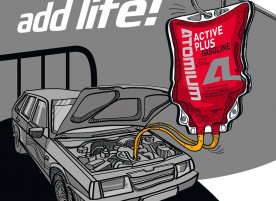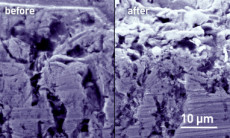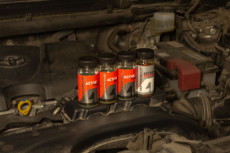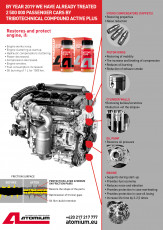Living water or a cure for old age?
Is it possible to revive a "dead" engine without major repairs, but only with the help of miraculous additives in engine oil? Unfortunately, no. And anyone who promises to create such a miracle is an ordinary charlatan.
Do you know who said that? The specialists of “Atomium”, a manufacturer of tribotechnical compounds – the ones additives for "restoring worn-out engines." It is for restoration, not for revival - they do not deal with resurrection miracles here. And by the way, they also do not encourage operating the engine without oil, although they have demonstrated this trick many times at various exhibitions.
What happens in the engine…
... when was the tribotechnical composition of "Atomium" filled in there? It all starts with the removal of carbon deposits, impurities and oxides – the restoring processes occur only on clean metal surfaces. Two conditions are necessary for the successful operation of the composition: friction and high temperature. Therefore, it will not "restore", for example, the surface of the oil channels, narrowing their cross-section. But in places of maximum friction and, consequently, maximum wear, a porous, but at the same time quite hard layer will appear, about 5 microns thick, with a low coefficient of friction. Which, moreover, holds oil perfectly – 3...5 times better than a honed cylinder mirror.
Is this even possible? Why not, it all depends on the materials used to repair worn parts.
Finely ground mineral
The main components of tribotechnical compositions are natural layered minerals serpentine and talcochlorite. They have a low coefficient of friction, are characterized by high thermal stability, and when added to engine oil, they can form a protective layer on friction surfaces during engine operation. Both minerals, especially serpentine, adsorb oil well. These properties of layered minerals have long been known and are not a mystery. Experts also know that when added to oil, natural ingredients must be carefully ground to the smallest fractions.
In “Atomium” believes that not only the particle size is important, but also their size and composition distribution. In tribotechnical formulations, 75% of particles are 1...5 microns in size, while the rest are slightly larger and noticeably more solid. The latter consist mainly of ore minerals, are used to clean surfaces and increase the "micro-friction", which stimulates the growth of the reducing layer. Large particles also act as a building material for repairing engine surfaces.
Where do the ore particles come from? Pure minerals are not found in nature, there are always certain impurities, the composition of which depends on the deposit and the depth of the fossil. The mineral used in “Atomium” tribotechnical compounds contains iron, titanium and copper compounds: magnetite, ilmenite, pyrite, rutile, bornite, which are also involved in the rejuvenation process of the engine. Hence the high hardness of the reducing layer, which, for example, talc, the main component of talcochlorite, will never give.
In addition, it is assumed that metal wear particles suspended in oil are also included in the process of restoring friction surfaces. But this is still only a version that requires proof.
How to use
We take a jar of “Atomium” (Active Plus), which corresponds to the parameters of your engine, and shake it thoroughly. Mineral particles suspended in ordinary industrial oil (which acts not only as their carrier, but also protects them from oxidation) tend to settle, which is normal. 500...1000 kilometers before the oil change, we send the contents to the oil filler neck. If the engine is heavily soiled, 200 km before replacement, we use a proprietary Atomium Engine Flush. After replacing the oil with fresh oil, we fill in the tribotechnical compound again and wait ... No, not a miracle – no one promised it to us, but a result. For severely worn-out engines, you may need another dose of the additive during the next oil change. Further, it is recommended to periodically use a special composition Active Regular/Active Plus to maintain the protective layer, then the effect will be as long-lasting as possible.
What can he do
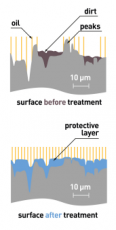 And what effect should we expect? The composition from “Atomium” will be able to move the piston rings (add more flexibility), the mobility of which is limited, and restore the surface of the cylinder – we will get an increase in compression, an improvement in the flow of the workflow, power restoration, and a reduction in oil and fuel consumption. Reducing the appetite of the motor will also be affected by a slight decrease in friction losses. Restoring gaps in the oil pump and crankshaft necks will help to normalize oil pressure.
And what effect should we expect? The composition from “Atomium” will be able to move the piston rings (add more flexibility), the mobility of which is limited, and restore the surface of the cylinder – we will get an increase in compression, an improvement in the flow of the workflow, power restoration, and a reduction in oil and fuel consumption. Reducing the appetite of the motor will also be affected by a slight decrease in friction losses. Restoring gaps in the oil pump and crankshaft necks will help to normalize oil pressure.
How noticeable this effect will be depending not only on compliance with the technology of processing an elderly motor, but also on its initial condition. If the engine has just begun to show signs of aging, then timely treatment will be as effective as possible and the engine will be able to restore its former youth. When the "patient is already bad”: compression has noticeably decreased, oil consumption has begun to grow steadily, the engine has become worse, we can only talk about a slight improvement in performance and an extension of the “old man's” resource.
And what can't
Tribotechnical compounds have one feature – they interact with iron and therefore form a reducing layer only on steel and cast-iron parts. Therefore, the compounds will not help engines with an aluminum block and metal-ceramic cylinder coating (alumina). Only piston rings are processed in nicasil-coated Cylinder-Piston-Groups. The thickness of the recovery layer is limited and it needs friction to form. They will not be able to completely remove the deep scuff marks in the friction pairs and return the gaps into which the "finger fits" to the nominal value. The additives are also unable to bring back to life fully embedded, coked or critically worn piston rings.
If the engine is dying: it consumes more oil than fuel, smokes, rumbles and barely starts - it has a direct path to repair or landfill. “Atomium”, created on the basis of well-known, generally recognized, although not fully understood processes, is powerless here. For miracles, please contact magicians, psychics and other clairvoyants.
P.S.
By the way, about driving without oil: “Atomium” tribocompounds allow the engine to run "dry" for a long time. But this does not mean that you can ignore the red emergency pressure symbol and ride on. The driver only has the opportunity to remove the car from a busy highway without harming the engine, get to a service station (if it is close) or to a place where a rescue tow truck can arrive. Otherwise, major repairs will be carried out in the very near future, and no tribotechnical staff will help you in this case.
